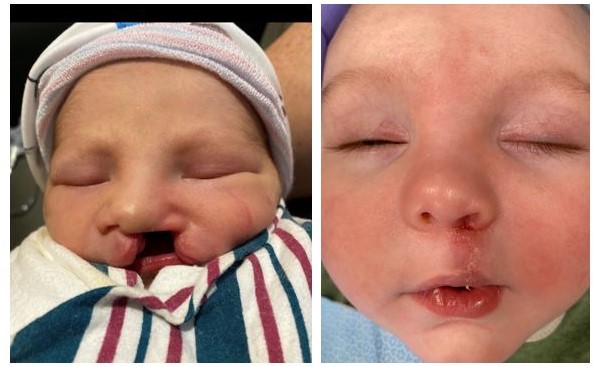Doctors diagnosed Tate Sawyer of Oakley, Illinois, with a cleft lip and suspected palate while in utero, with his first visit to a physician happening only a few days after his birth.
“That first experience of being diagnosed at 20 weeks was scary,” said Tate’s mother, Hannah Sawyer. “We met with Dr. Manlove and her team at 22 weeks. They made us feel comfortable and well informed on what to expect. Dr. Manlove was always sweet with Tate and still is.”

Cleft lip and cleft palate are facial birth conditions that occur when part of the nasal process and part of the upper lip process don’t fuse before a baby is born. Similarly, a cleft palate is a condition that occurs when the palatal shelves, or roof of the mouth, do not fuse before a baby is born.
Ashley Manlove, DMD, MD, with Carle Oral and Maxillofacial Surgery was the physician who treated Tate after he was born.
 An experienced and acclaimed physician, she is the recipient of the Faculty Educator Development Award (FEDA) from the American Association of Oral and Maxillofacial Surgeons (AAOMS) in 2021. She also received the Rising Star Physician Excellence award in 2019.
An experienced and acclaimed physician, she is the recipient of the Faculty Educator Development Award (FEDA) from the American Association of Oral and Maxillofacial Surgeons (AAOMS) in 2021. She also received the Rising Star Physician Excellence award in 2019.Dr. Manlove is responsible for bringing the nasoalveolar molding treatment to Carle Health.
Nasoalveolar molding, or NAM, is a custom appliance that brings together the two side of a cleft lip or palate to give the nasal cartilage more support before surgery. It also decreases tension at the surgical site.
“We adjust the appliance every week to slowly pull the segments together before surgery,” said Dr. Manlove. “It provides nasal molding so the nose and lip are more symmetrical after surgery.”
“I looked into NAM because I had so many patients who read about it and requested it,” said Dr. Manlove. “No one in the region was providing the treatment. The closest providers are in Chicago and St. Louis. So, I took an intensive, hands-on course to learn the intricate details of NAM. I want to bring this resource to our patient base and Carle supports what is needed to bring this next level of care to those we serve.”

Dr. Manlove also created an online cleft and craniofacial support group for parents to connect with surgeons and medical professionals, share stories, find support and have their questions answered.
“When Tate was seven days old, I took an impression of his upper jaw and a week later the appliance was delivered, said Dr. Manlove. “We saw him every week for adjustments to the appliance for about 15 weeks of NAM therapy before surgery. It reduced his cleft size from 14 millimeters to one and a half.”
Tate was also seen by a dental specialist, orthodontist and speech pathologist alongside Dr. Manlove’s team to learn how to bottle feed and help support Tate’s parents in caring for their first child throughout this experience.
 “It was overwhelming and stressful, and it was uncomfortable for him with bandages on his face,” said Sawyer. “But eventually he got used to it and actually wanted the NAM in, like a security thing. And we could see the progress. We were very pleased with the process and how it was working for him.”
“It was overwhelming and stressful, and it was uncomfortable for him with bandages on his face,” said Sawyer. “But eventually he got used to it and actually wanted the NAM in, like a security thing. And we could see the progress. We were very pleased with the process and how it was working for him.”“NAM treatment is more commonly done by an orthodontist or pediatric dentist, but I do it because there was a need in my community,” said Dr. Manlove. “You build a relationship with the patients and know what their treatment goals are. I see them through to the end to set them up for success.”
Tate is 18 months old now and has completed the NAM treatment and surgery, and his parents are very happy with the outcome for their son.

“I would like readers to know we highly recommend the NAM because it did nothing but benefit Tate and we get compliments on how good his lip and nose look,” said Sawyer. “And I think it’s the NAM and Dr. Manlove who made it turn out so well. It’s time consuming and stressful but in the best interest of the child.”
To join the Cleft and Cranial Support group, visit the page on Facebook.
For more information about cleft lip or palate treatments, visit Carle.org.
Categories: Redefining Healthcare
Tags: Cleft, Craniofacial, Group, Lip, Maxillofacial, Oral, Palate, Patient, Pediatrics, Story, Support, Surgery
